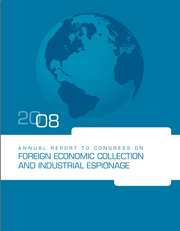Citation[]

Office of the National Counterintelligence Executive, 2008 Annual Report to Congress on Foreign Economic and Industrial Espionage (July 23, 2009) (full-text).
Overview[]
This assessment is submitted in compliance with the Intelligence Authorization Act for Fiscal Year 1995,[1] which requires that the President annually provide to Congress updated information on the threat to U.S. industry from foreign economic collection and industrial espionage.
This report updates the Annual Report to Congress on Foreign Economic Collection and Industrial Espionage, 2007 with data from FY 2008.
This report covers a range of activities — under the rubric of industrial espionage — directed at trade secrets.
Economic espionage cases went up slightly from 2007 and nearly every day brought reports — in the press and in the classified world — of new cyber attacks against U.S. Government and business entities. Additionally, the increasing use of new modes of communication and social networking provided uncharted opportunities for transferring information and spying on the part of enterprising foreign intelligence services.
According to evidence amassed by the U.S. counterintelligence community, a wide variety of foreign entities continued to try to illegally acquire U.S. technology, trade secrets, and proprietary information. With companies encouraging outsourcing of research and development (R&D) and establishing foreign bases of operation, foreign entities had more opportunities to target U.S. information and technologies and mask their collection activities. As a result, it was increasingly difficult to measure fully the extent of their espionage and illegal acquisitions.
References[]
- ↑ Section 809(b), Pub. L. No. 103-359.